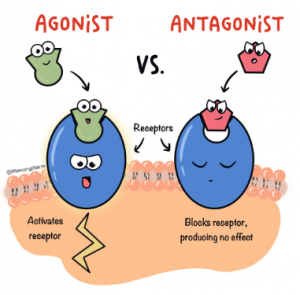Writers must choose a word that is not used in day-to-day vocabulary. The objective of this assignment is to create 3 types of definitions which can be used for different situations. The criteria indicates that writers must create an expanded definition, a parenthetical definition and a sentence definition based on a chosen word typically used in professional or academic settings.
SITUATION AND AUDIENCE
On the surface, agonist drugs seem to have a positive effect. In this case, a school nurse presents the different consequences of agonist drugs to a high school class. As such, the school nurse explains the chemical changes that agonists can make to their brain.
PARENTHETICAL
The agonist (drug-heightening effect) can alleviate chronic pain.
SENTENCE
Agonist is a drug that affects the brain on a cellular level. This type of drug stimulates brain chemicals to increase its function.
EXPANDED DEFNITION
Operating Principle
In order for an agonist to work, it needs to bind to a chemical neurotransmitter (chemical messenger that carries signals to other parts of the brain) in order to heighten the response of the chemical. A natural or pharmaceutical agonist drug attaches itself on a receptor (part of a cell on the receiving end of a chemical signal) as a way to signal the chemicals to turn on (Modi, “Agonist vs. Antagonist: What’s the Difference?”).
Negation
Agonists increase the activity of a chemical response but it does not subdue or decrease a response of chemical activity.
Compare and Contrast
In comparison, opioids are pharmaceutical agonist drugs which display similar properties to body-producing endorphins. In contrast to agonists, Advil inhibits chemicals and does not cause a response from the brain.
Examples
Agonists such as hallucinogens, opioids and heroin are different pharmaceutical agonist drugs (Indian Health Service). Human bodies also create agonists such as endorphins to alleviate pain (Modi, “Agonist vs. Antagonist: What’s the Difference?”).

Figure 1: Agonist is shown increases activity through the receptor whereas an antagonist blocks receptor from functioning.
Work Cited
Modi, Juhi. “Agonist vs. Antagonist: What’s the Difference?” Buzzrx.com, BuzzRx, 18 Feb. 2022, https://www.buzzrx.com/blog/agonist-vs-antagonist-whats-the-difference.
Pharm, Memory [Memory Pharm]. “How agonists & antagonists work. An agonist is a drug that binds to a receptor & activates it. An antagonist is a drug that binds to a receptor without activating it, but instead, blocks the receptor from being activated by other chemicals in the body.” Twitter, 3 August 2021, https://twitter.com/MemoryPharm/status/1422565665504993284/photo/1
“Pharmacological Treatment: Medication Assisted Recovery.” Opioids, Indian Health Service, https://www.ihs.gov/opioids/recovery/pharmatreatment/#:~:text=An%20agonist%20is%20a%20drug,%2C%20morphine%2C%20opium%20and%20others.
Leave a Reply